DNA Types Changed According to Surroundings!
Contents:
1. Introduction.
2. YDNA HaploGroups A and B.
3. YDNA HaploGroups E.
|
Brit-Am Discussion Group |
Contents by Subject |
Research Recognition Reconciliation Contribute |
|
Site Map Contents in Alphabetical Order |
This Site |
Haplogroups and Environment.
Correspondence of YHaplogroups to Specific Climes and Locations.
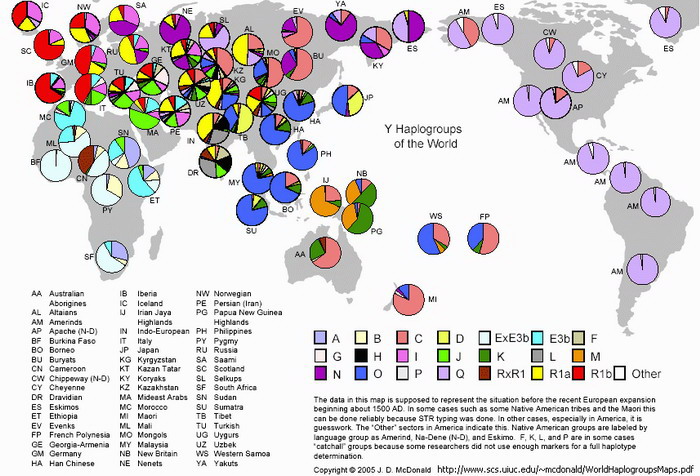 |
1. Introduction.
DNA studies divide mankind into different groups according to haplogroups (meaning DNA groups??).
There are YDNA haplogroups that trace DNA through only through male ancestry.
There are mtDNA haplogroups that trace DNA through only through female ancestry.
At least in theory.
It is now agree that mtDNA may be influenced by the environment.
It is also agreed that every once in a while the mtDNA is influenced by the male side and not only the female.
Male YDNA haplogroups are based on "junk" DNA which was supposed at first to have no function and therefore not liable to be influenced by environment.
It is now agreed that "junk" DNA is constantly active and functional:
[see references to Noncoding DNA:
# many types of noncoding DNA sequences do have [now] known biological functions #.
We are interested in DNA because it helps us trace different peoples and show the interrelationships amongst them.
We believe it may be useful.
Nevertheless it also seems certain that environmental influence at some stage in the past does determine YDNA haplogroups.
This however is not yet "officially" acknowledged.
As soon as acknowledgement is forthcoming there may be studies showing how and when the YDNA changes take place. We will then be able to consider to what degree they are attributable to hereditary and what and when they are not.
There is a related science called Epigenetics.
Epigenetics however studies how DNA-sequences vary in their applications (switch on and off) according to environment but the underlying pattern remains the same.
For example:
# The plant Hieracium umbellatum is found growing in two different habitats in Sweden. One habitat is rocky, sea-side cliffs, where the plants are bushy with broad leaves and expanded inflorescences; the other is among sand dunes where the plants grow prostrate with narrow leaves and compact inflorescences. These habitats alternate along the coast of Sweden and the habitat that the seeds of Hieracium umbellatum land in, determine the phenotype that grows. #
Source:
Phenotype
http://en.wikipedia.org/wiki/Phenotype
 |
In this case the DNA sequence of the plant remains the same but different sections of the sequence are activated according to environmental needs.
In other cases however the genetic structure does change. In the article,
Phenotypic and Genetic Variation; Ecotypes
Examples of changes in plants according to environment are discussed. The differences involve both "epigentic"-type cases where the Genetic structure remains the same (but different sections are "activated" according to need) and those in which genetic changes occur to accomodate the environmental need.
e.g.
In Europe and the Near East, clinal variation manifests itself in the glycoside concentration of the leaves of Trifolium repens. Occurrence and distribution of the corresponding genes correlate strongly with the 0°C – January – isotherm. Other legumes display comparable differences. Glycosides (cyanide derivatives) are protective agents against browsing, by snails, for example.
Applying these principles to the genetic structure used to classify YDNA in humans we would say that Genetic changes in the DNA reflect inbuilt possibilities for change existing from the beginning. Differentiations in the genes are triggered off by external stimuli. This fits the facts better than the conventional "evolutionary" scenario. The evolutionists would say that random mutations occur until one just happens to bestow an environmental advantage on its possessor enabling it to survive with more success than less fortunate specimens who were not similarly affected.
The difference between YDNA haplogroups is that of genetic structure but not basic. In very simplified terms A is the first building block. B will have all that A has but with an additional "branch". The next after B will have all that both A and B has plus the addition found in B plus an extra addition of its own. And so on until we reach N, O, R, and Q at the top.
See Also:
Y DNA "Evolutionary" Sequence Reversed!
Our impression is that YDNA haplogroups (like mtDNA ones) also owe the differences between each other to environment.
In other words the additions or lack of them are determined by the physical location and type of surroundings.
Once the differentiation has taken place it is inherited until the next change occurs.
DNA is therefore useful in tracing inherited patterns and in distinguishing one group from another BUT only up to a limit.
We would like to gain some notion as to where the limit lies.
We do not believe in Evolution but rather in adaptation within preset parameters according to inbuilt genetic mechanisms.
The series of articles below is intended to discuss the Correspondence of YHaplogroups to Specific Climes and Locations.
If such a co-relationship is seen to exist it will not absolutely prove anything but it may provide a needed perspective for later findings.
Our discussion will follow the progression of YDNA groups ("Out of Africa") adopted by mainstream researchers.
Our own understanding is that the "evolution" is in fact "devolution" from the Northern European type into Africa rather than out of it.
This however is a separate subject and for present purposes superfluous.
Even if one does not agree with us or has difficulty comprehending what we care getting at this series will be worth reading since
in the course of it we shall be describing the division of humanity into different groups according to DNA studies.
This knowledge may be worth knowing.
[Our main source unless otherwise noted, will usually (but not always) be different Wikipedia articles.]
We shall begin with Haplogroups A and B.
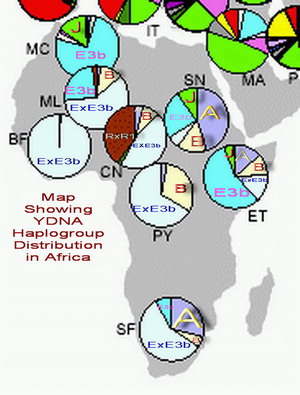 |
2. YDNA HaploGroups A and B
YDNA Haplogroups A and B (along with C, D, and E) are considered the simplest haplogroups from which the others "developed" or "evolved".
# Haplogroups A and B are only found in sub-Saharan Africa (and in populations extracted from there in modern times, primarily via the Atlantic slave trade and Arab slave trade). #
There are different types of A.
Haplogroup A (M91) Found in Africa, especially the Khoisan (Bushmen of South Africa), Ethiopians (especially Beta Israel) and Nilotes.
Khoisan are Bushmen of South Africa south of the Equator.
Beta Israel are Ethiopian Jews north of the Equator.
The Beta Israel are considered to have originally spoken Cushite (East African) languages.
They are to some degree of the original Proto-Ethiopian stock who converted to Judaism.
Nilotes are different admixtures of A, B, and E1b1b (general Negroid).
The Masai and Luo from Kenya are Nilotic as are the Dinga of the Sudan.
The father of US President Barak Obama is probably descended from Arab slave traders who settled amongst the Luo people in Kenya.
Nilotes are often described as gracile in build, being slimmer and of greater stature than the average human, and having long limbs with very long distal segments (forearms, calves). This characteristic is thought to be a climatic adaptation to allow their bodies to shed heat more efficiently.
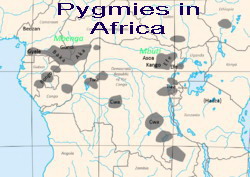
|
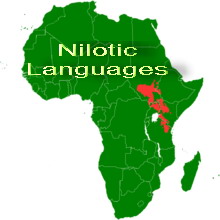
|
Many Nilotic groups excel in long distance running. This sort of sports excellence seems to stem from their exceptional running economy resulting from slim body morphology and slender legs.
Different Types of B.
BT (M42, M94, M139, M299) ca. 55 ka BP Haplogroup B (M60) Found in Africa, especially the Pygmies and Hadzabe.
Hadzabe number less than a 1000 and are found in Tanzania north of the Equator. Considered a primitive hunter-and gathering people with a clicking language like that of the Khoisan.
The Pygmies of Africa are found in rain-forest areas in Central Africa.
The Pygmies of Africa are defined both by latitude and by surroundings.
Other types of Pygmies are found in other parts of the world.
In Indonesia the Rampassa have light skin. In New Guinea the pygmies have dark skin along in many cases with blond and red hair such as also found in Melanesia and Polynesia.
The Negritos of southeast Asia look Negroid but anthropologists consider this resemblance to be superficial since in other ways they are quote different.
Wherever pygmies are found they seem to dwell in rain-forest areas.
YHaplogroups A and B are found ONLY in sub-Saharan Africa.
Intermediate Conclusion:
Y Haplogroups A and B would appear to pertain to groups that show some physical similarity.
B is marked by small stature.
A is more mixed with other groups and includes Nilotic elements some of whom can be very tall.
B is to be found mainly in rain forests in the Center of Africa. A is found to the north and south of B, in more open country.
A physically is like unto B in some cases but elsewhere is often taller.
For A and B it may be said that there exists a close correspondence to climate, environment, placement (latitude), and even life style.
We also found an overlap with physical types.
A glance at the map will show that wherever either A or B are to be found they will be beside each other. It is as if one type merges into the other (or derives from the other) according to environmental circumstances.
As we continue this study with other Y haplogroups we will not always find such parallelisms though over-all tendencies will be apparent.
In general, A and B are to be found on the Equator (B) and just north and south of it. They pertain to non-Negroid African groups who were in their present locations before the Negroid incursion.
We have YHaplogroups A,B, C, D, and E.
Native Y Africans are A, B, E. The types C and D are to be found in Asia.
C and D are not really intermediate.
There is no real progression in DNA from A to B.
[Actually from A to a hypothetical BR and then to B.]
They are brothers.
They gave rise to DE (D and E) and CF (C and F). These too may be considered as brothers rather than as parents of offspring.
We may therefore take the African groups A, B, E as one entity with E
somehow derived from (or giving rise) to A and B.
E is mainly Negroid but one type (E1b) is white and is found in North Africa and southern Europe.
This was also the reported haplogroup of Adolf Hitler.
http://www.eupedia.com/forum/showthread.php?25936-Hitler-belonged-to-Near-Eastern-Y-haplogroup-E1b1b
We will discuss haplogroup E at more length later.
Female Parallels.
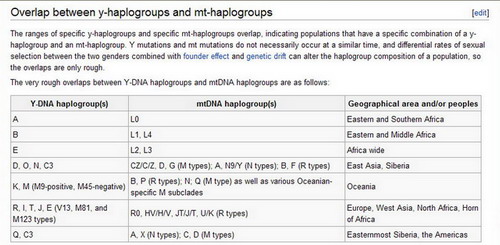
|
mtDNA companion of A is LO pertaining to Eastern and Southern Africa.
mtDNA companion of B is L1, L4 pertaining to Eastern and Middle Africa.
mtDNA companion of E is L2, L3 pertaining to All of Africa.
All of L is the companion of Dark Africa.
The type of L that became the companion of E is differentiated from the others.
African: L0, L1, L2, L3, L4, L5, L6
mtDNA Haplogroup # L0d is the most divergent ("ancient") haplogroup of global mitochondrial DNA haplogroups. It is found at highest frequencies in the Khoisan groups of Southern Africa. L0d is also commonly found in the Coloured population of South Africa and frequencies range from 60% to 71%. This illustrates the massive maternal contribution of Khoisan people to the Coloured population of South Africa. #
LO is the partner of A. LO is also found in East Africa as the partner to other groups who apparently took women from YDNA haplogroup A.
L1 is the pygmy female also taken as captives by other groups.
L2 is African in general.
L3 is East African but also found in Arabia and considered the "mother" of ALL non-African mtDNA haplogroups!
# According to Maca-Meyer et al. (2001), "L3 is more related to Eurasian haplogroups than to the most divergent African clusters L1 and L2".[7] L3 is the haplogroup from which all modern humans outside of Africa derive.[8] #
L4 is found in Tanzanzia and among the Hadza (Hadzebe) who like the pygmies are B.
See Also:
Y DNA "Evolutionary" Sequence Reversed!
YDNA Haplogroups Determined by Climate!

Pleased with what you read'
Click Here to make an offering. |
'It is impossible to rightly govern the world without
God or the Bible.'
George Washington
Brit-Am is the "still small voice" that contains the truth.
"after the earthquake a fire, but the LORD was not in the fire; and after the fire a still small voice"
[1-Kings 19:12].
 |
 |
